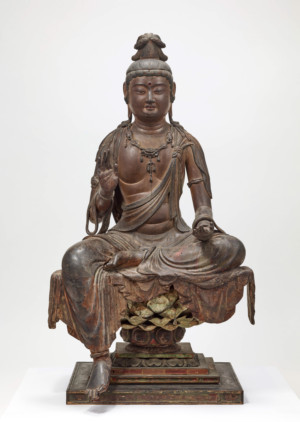British Museum Announces Collaboration And Display With Nara, Japan

The British Museum has announced a special free display across two locations within the Museum of 15 major Buddhist and Shinto sacred images, to be loaned this autumn from Nara Prefecture in Japan. The works date from the AD 600s through the 1300s and include 5 Japanese National Treasures and 6 Important Cultural Properties. The sacred sculptures and ritual objects from Nara will be displayed together with related important Japanese and Chinese paintings from the collection of the British Museum.
Nara is the eastern terminus of the silks roads that brought trade and continental Asian culture, including Buddhism, to Japan in the period from the AD 500s to the AD 700s, transforming indigenous society. Buddhism was championed by Prince Sh toku Taishi (AD 574-622) at what became the religious complex of H ry ji temple, near Nara. In 752 Emperor Sh mu (AD 701-756) dedicated the great bronze Vairocana Buddha at T daiji temple, destroyed and reconstructed twice during its long history and still the symbol of Nara today.
Notwithstanding partial destruction in the 1180s, 1560s and 1870s, Nara has each time revived and sustained its ancient religious traditions, in which Buddhism has generally coexisted peacefully with worship of native deities known as kami (modern Shinto). The great temples and shrines of Nara are on this occasion loaning a range of significant sacred images traversing some eight centuries of Japanese history.
Highlights include a sublime gilt bronze sculpture Bodhisattva of Compassion (known as 'Dream-changing Kannon',Yume-chigai Kannon, National Treasure) dating from the early AD700s, loaned by H ry ji temple; and Libation dish, with Birth of the Buddha (National Treasure),also gilt bronze and dating from the mid-AD 700s, loaned by T daiji temple. This libation dish is thought to have used in rituals performed at the dedication of the original Great Buddha. An imposing pair of wood sculptures Heavenly Kings, also AD 700s, loaned by T sh daiji temple, have only recently been designated as National Treasures.
British Museum Director Hartwig Fischer said: 'We are thrilled to welcome these rare Buddhist and Shinto treasures from Nara to the British Museum, where they can be enjoyed for free by visitors from all over the world, in company with the Museum's own global collections.'
The Asahi Shimbun Executive Director Tomoichi Ichimura said 'We are very pleased to be able to introduce Japanese Buddhism and Shinto in the Asahi Shimbun Displays (Room 3), which we hope many people will come to see. It is also our wish that people from the UK and other parts of the world will visit Nara, an ancient capital of Japan, where one can experience and enjoy various forms of Japanese art
Governor of Nara Prefecture Mr Arai Sh go, said: 'The British Museum has a long tradition of collecting and displaying precious cultural artefacts from all over the world. I am grateful that the Museum has created this opportunity to display Buddhist sculptures and Shinto art from Nara in Japan, so as to convey their beauty and spiritual essence. Japan's ancient capital city of Nara benefitted from cultural exchanges along the Silk Road, creating the foundations for traditional Japanese culture. We hope people will savour this encounter with its deep roots'
Lenders to the special displays: H ry ji temple; Yakushiji temple; T daiji temple; T sh daiji temple; Saidaiji temple; Kasuga Taisha shrine; Niu Kawakami Jinja shrine; Agency for Cultural Affairs of Japan; Nara National Museum; Tokyo National Museum
Guest curators: Samuel Morse, Amherst College, USA; Nedachi Kensuke, Kyoto University
Part of UK-Japan Season of Culture 2019-20
Comments
Videos

